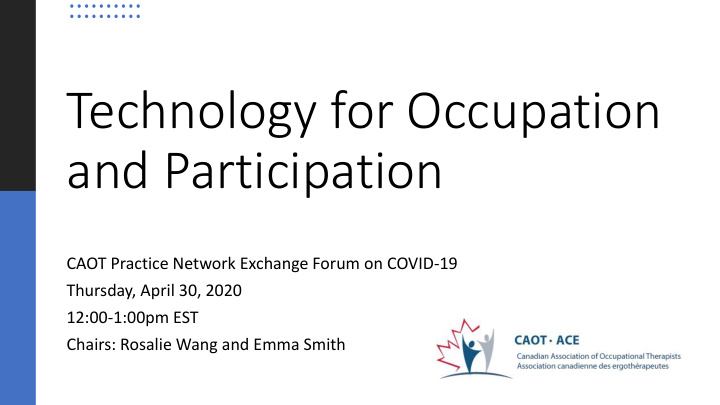



Technology for Occupation and Participation CAOT Practice Network Exchange Forum on COVID-19 Thursday, April 30, 2020 12:00-1:00pm EST Chairs: Rosalie Wang and Emma Smith
Agenda • Introductions • About the network and our activities • Implications of COVID-19 on OT practice and role of technology
Focus on how OTs use technology to facilitate occupation and About the Network… participation • Sharing Sessions: Share what works, what’s new, ask questions • Social Media: Connect with colleagues • Continuing Education: By members, for members • Leadership: Supporting CAOTs advocacy, advancing the field
COVID-19, OT practice and role of technology 1. Tele-OT: Facilitating care delivery 2. Sharing accessible information: Equity in information delivery 3. Mitigating impact of physical distancing: Enhancing social connectedness 4. Tele-work: Supporting work from home Now (our lives during pandemic) → Future (how we envision life post-pandemic, impact of pandemic on OT practice - establishing/sustaining changes for the better)
1. Tele-OT: Facilitating care delivery Now… Future… Rapid, urgent expansion in use More collaborative service models of technologies for providing Updated (or sustained) legislative and services/continuity of care regulatory support for tele-OT Demonstrated ability and rationale Overnight enhanced capacity (benefits) for adoption of tele-OT of OTs to practice through tele- Pressure to develop tools to address technology limitations in tele-OT (e.g. physical assessment) and guidelines for best practice Opportunities for more efficient/rural/remote service delivery
2. Sharing information Now… Future… Enhanced pressure in Greater advocacy by consumers and OTs on emergency response to share need for accessible information as a human information in accessible ways, right, not as a matter of convenience e.g. formats that are accessible OTs working with clients as guides to for everyone and of all abilities, governments and organizations on through technology developing accessible information sharing opportunities
3. Mitigating impact of physical distancing Now… Future… Physical distancing, social Some people who had not previously adopted connectedness these technologies after testing them may see the benefits and sustain use (e.g. older adults) Use of ICT helps people to stay in contact, mitigating social isolation Greater advocacy for information and Understanding of the necessity communication technologies (ICT) as human and benefits right Forced adoption because of necessity – OTs can help to support use Greater awareness of digital divides – age, socio-economics, education, rural/remote
4. Tele-work: Supporting work from home Now… Future… People with disabilities may New work norm established because not be employed because people see the benefits = equalization of could not get to work settings job opportunities easily, not always have suitable accommodations Greater advocacy for work accommodations to support people with Through technology, people disabilities to work from home are asked to work from home if their jobs allow Work from home technologies must be accessible and meet the needs of people Increased flexibility for working with disabilities (e.g. captioning in live chat, and work environments switch access)
Join our network! Interested in Technology for Rosalie.Wang@UToronto.ca Occupation and Emma.M.Smith@gmail.com Participation?
Recommend
More recommend